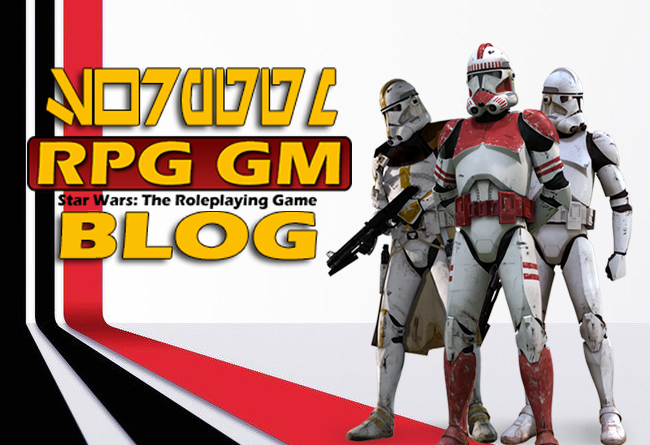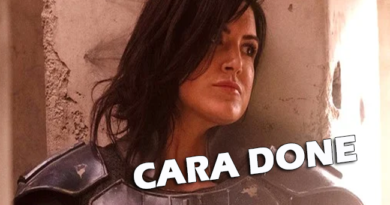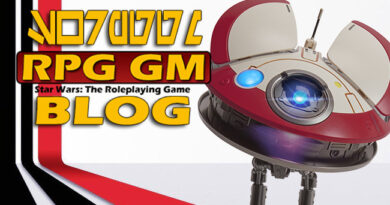The Different Classes of Clone Trooper
Clone Ranks and Basic Stats

Clone Rank Identification is seen through the heads up display (HUD) using a Republic visor. A clone’s transmitter would display their rank and their Identification number on the HUD for Clones to identify each other. During a battle a clone had the option to configure their helmet to show a clone’s rank above each individual or only display rank when the target is directly in front of them. Early in the Clone Wars certain ranks would also have identifying paint on their armor to aid Jedi in knowing who was who but this feel out of favor quickly in the first year of the war.
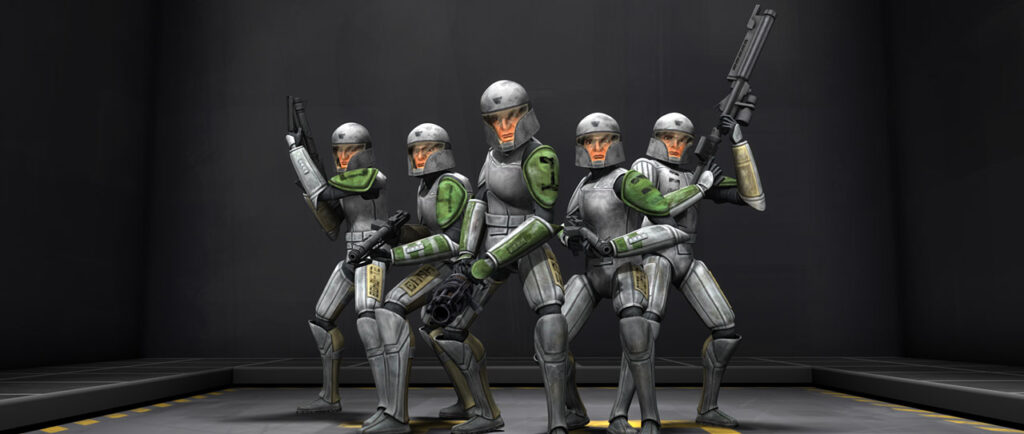
Cadet (Rookie)
The Clone Cadets are the lowest rank amongst the clones but where all clones begin. They spend the first 10 years of their lives as a cadet, being trained, tested, and evaluated for their future roles. This is the phase where the clones begin to be separated into their future career paths and beginning ranks. Clones that show skills needed in the officer corps are first selected at age 5 and put on a different training regiment than clones who will fill enlisted roles. All clones are trained for basic ground combat, tactics, and weapons training. They also have the option to train in a specialty like Jetpack, SCUBA, Cold Assault, etc … Clones are again assessed at age 8 for transition to Naval or Army units based off their testing scores and are sent to specialized training for each branch. Clones selected for the officer corps have an additional officer basic training after they complete their basic training skills.
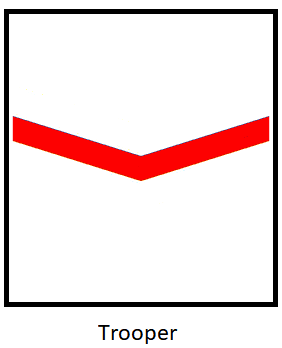
Private / Trooper
The Private or Trooper is the first rank is the lowest rank for enlisted Clones. Their stats reflect they have completed basic training and have the skills to follow orders and to complete basic tasks with guidance from higher ranks.
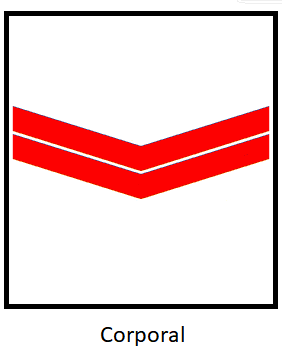
Corporal
Clone Corporals are in charge of privates when a sergeant or higher rank is unavailable and can preform duties with little supervision.
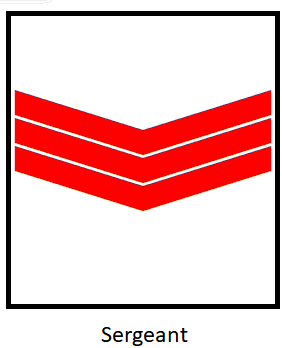
Sergeant (Experienced)
The Clone Sergeant is a experienced Clone with higher stats than a Corporal or Private and the first rank of Non-Commissioned Officer. They serve as the squad leader when an officer or Sergeant Major was not in charge. A sergeant would usually command squads of nine troopers. During the early days of the Clone Wars Sergeants wore armor featuring four green colored circles on the left chestplate as well as a stripe of pesto down the length of each arm, vertically up the middle of the helmet and laterally around the visor.

Sergeant Major (Veteran)
Clone Sergeant Major had green markings in the early stages of the Clone Wars, and like the rank equivalent in the Galactic Empire, commonly served as second-in-command of a platoon. During the early days of the Clone Wars Sergeant Majors wore armor featuring four green colored circles on the left chestplate as well as a stripe of pesto down the length of each arm, vertically up the middle of the helmet and laterally around the visor.
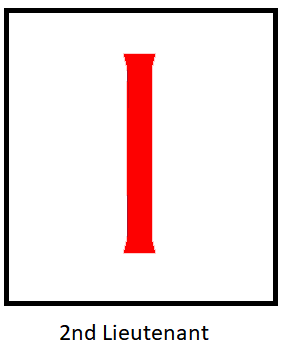
2nd Lieutenant
Second Lieutenants in the Grand Army of the Republic were the lowest rank of officer. Along with the 1st Lieutenants they commanded platoons of thirty-six troopers and held the unit position of platoon leader. The four lieutenants of a company were in turn led by their respective clone captain. Standard Phase I lieutenants wore clone trooper armor featuring four blue colored circles on the left chestplate as well as a stripe of blue down the length of each arm, vertically up the middle of the helmet and laterally around the visor.

1st Lieutenant
The second rank of the officer corp, the 1st Lieutenant was promoted when they achieved enough time with the enlisted troopers to lead. Their skills in command increased they would command platoons of thirty-siz trooper and held the unit position of platoon leader. Standard Phase I lieutenants wore clone trooper armor featuring four blue colored circles on the left chestplate as well as a stripe of blue down the length of each arm, vertically up the middle of the helmet and laterally around the visor.
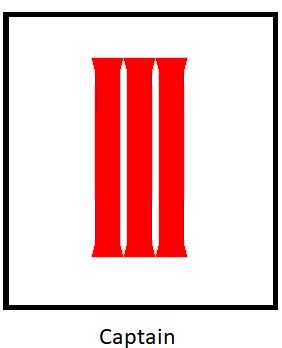
Captain (Elite)
The Clone Captain is the middle rank of the officer corps and the first of the Elite rank. These veterans had enough time in the field and skill to be a weapon unto themselves. A Captain commanded companies of 144 troopers, although this limitation did not apply to every captain. The sixteen captains of a regiment were in turn led by their respective Clone Commander, or in some cases, a Jedi General. Standard Phase I captains wore armor featuring four maroon circles on the left chestplate as well as a stripe of maroon down the length of each arm, vertically up the middle of the helmet and laterally around the visor.
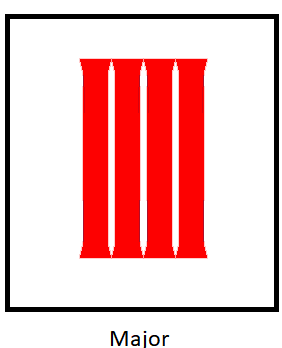
Major
Clone Majors who were placed in command of a battalion of soldiers along side a clone battalion commander, and had red armor flashes during the early days of the Clone Wars. Clone majors also had red stripes like clone captains. Majors would typically be located either behind the lines or in forward operating bases or vehicles like the HAVw A6 Juggernaut.
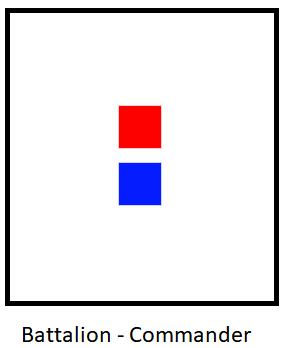
Battalion Commander
A clone battalion commander was a lower-ranking clone trooper commander in the Grand Army of the Republic. The position denoted leadership of a battalion-level formation, a unit of the Grand Army during the Clone Wars. A battalion consisted of 660 clone troopers subdivided into four companies, and a battalion commander was supported by a major. The battalion commander and major were supported by four clone trooper captains, each of whom led a company.
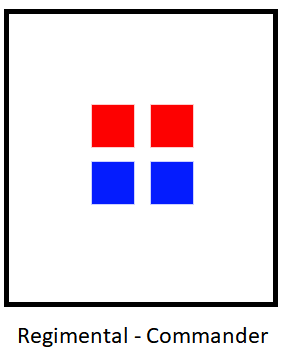
Regimental Commander
Clone Regimental Commanders were clone trooper commanders placed in command of regiments. A regiment normally consisted of four battalions (2,304 troopers) led by a Jedi Commander or a Clone Commander. The Regimental Commander would normally be found in the Regimental headquarters or located at a battlefield command headquarters.
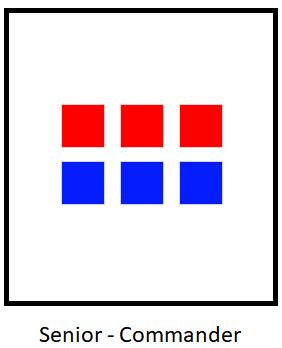
Senior Commander / Naval Captain
Senior Commander or Captain in the Navy was a rank within the Grand Army of the Republic among the Clones, in particular, it acted as the second-highest rank among the clones, with only Marshal Commander outranking it. Senior Commanders led Legions which consisted of four regiments (9,216 troopers) led by a Jedi General.
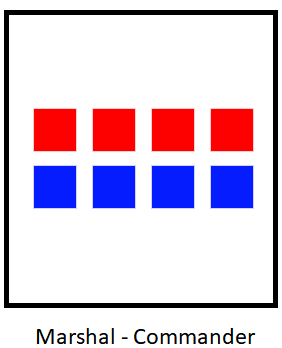
Marshal Commander / Admiral
A Clone Marshal Commander, or simply known as a Marshal Commander, was a high-ranking clone trooper commander, usually in command of a corps-level formation alongside a Jedi General counterpart. The Corp consisted of four legions (36,864 troopers) led by a Jedi General and the Marshal Commander. This was the highest rank a Clone could achieve in the Grand Army of the Republic. In the Republic Navy this rank was that of Admiral.
Clone Occupational Specialty
Trooper
The Trooper is the main land combat force and the backbone of the Grand Army of the Republic. Their role is to be ready to defend assests and to capture, destroy and repel enemy ground forces during combat. Troopers assist in the performance of reconnaissance operations, employ, fire, and recover anti-personnel and anti-tank mines, and locate and neutralize mines, operate, mount/dismount, zero, and engage targets using night vision sight. Troopers also might process prisoners of war and captured documents. They also are trained to lead an infantry team in combat operations, providing tactical and technical guidance to subordinates and professional support to both superiors and subordinates in the accomplishment of their duties; lead, supervise, and train subordinate personnel.

Medic
As a Medic, Clones administer emergency medical care in the field in both combat and humanitarian situations. They serve as a first responder and triage illnesses and injuries to save lives. They also train other Soldiers in lifesaver/first responder courses. Clone Medics are selected for training when they arrive at their unit.

Gunner
The Clone gunner is the technical and tactical experts for their weapon’s platform. They advise the commander on everything related to the vehicle platform and weapon’s system. They also develop training materials to conduct gunnery and live-fire exercises. They operate mass driver cannons and laser turrets on various ground vehicles. Clones can be selected for this occupation upon graduation or request transfer after with permission from their unit. Clone Gunners upon graduation would be selected to serve in the Republic Army or Navy and receive specialized training when they arrive at their unit. Clone Naval gunners operated the various weapons and point defense systems on Capital Ships under the guidance of a Naval Weapons Officer.

Special Operations Trooper
Special ops clone troopers, also known as stealth ops clones. Equipped with specialized clone trooper armor, special ops clones were trained for stealth and served with distinction in the Clone Wars. Clones could volunteer for Special Ops training when they are a cadet.
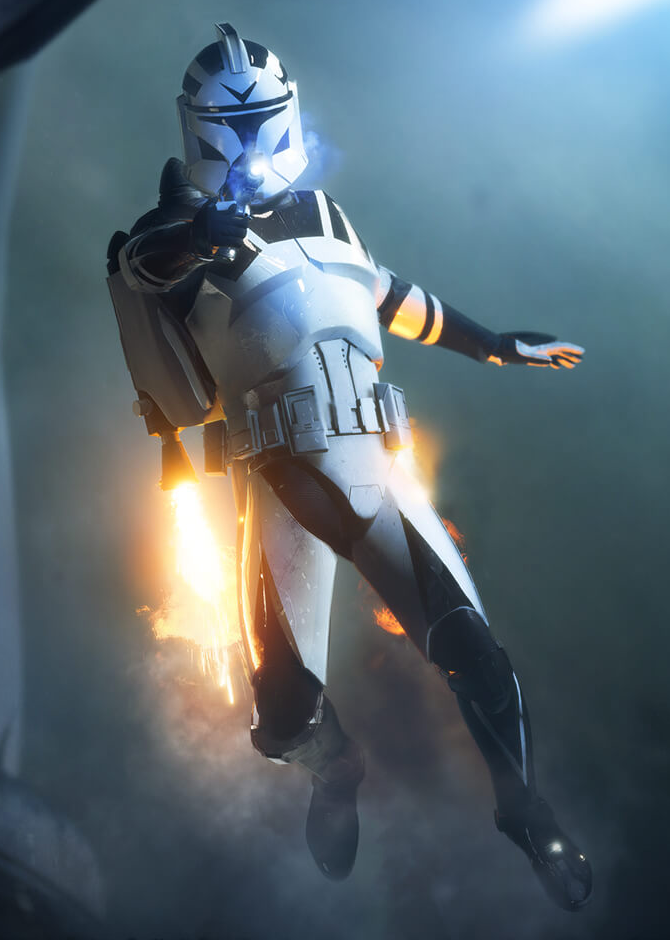
Jetpack Trooper
Clone Jetpack Troopers were trained for aerial combat, most commonly through the use of the JT-12 jetpack. They were armed with the BlasTech DC-15A blaster rifle, DC-15A blaster carbine, and DC-17 hand blaster as well as missile launchers, including Smart Rockets. This was a special duty training assignment that Clones could volunteer for during basic training.
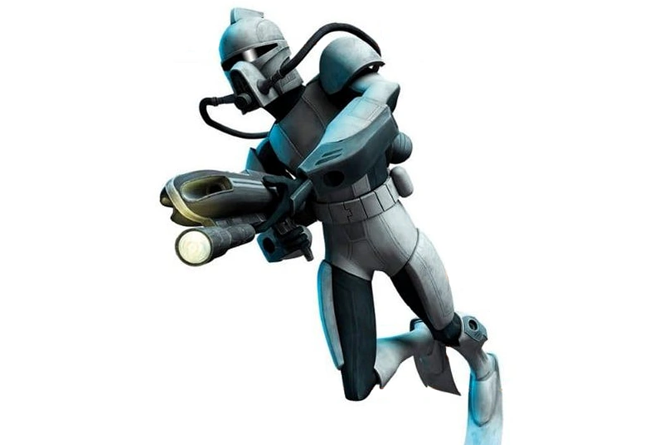
SCUBA Trooper
Clone SCUBA Troopers who were outfitted for combat in aquatic environments. Clone SCUBA troopers wore a set of white armor, known as Clone Dive Armor, that was fitted with six underwater propulsion jets to aid their movement. To survive underwater, they carried a scuba backpack kit that was equipped with gill grills and a pair of breathing tubes which circulated oxygen into their helmets. Clone SCUBA troopers were also armed with a DC-12U beam rifle, a double-barreled gun equipped with a flashlight. They also wore white fins which could be attached to their boots. They also received training in the use of the OMS Devilfish sub. Clones could volunteer for SCUBA Trooper training during their basic training.
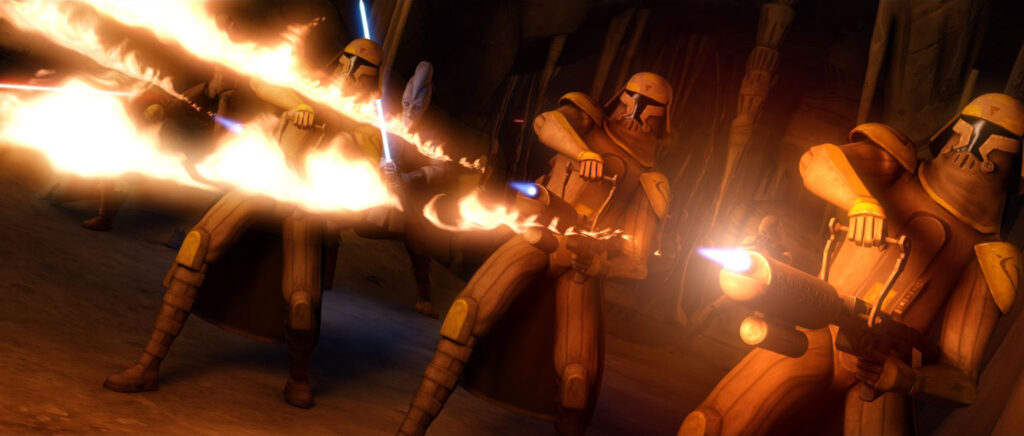
Flame Trooper
Clone flame troopers, were a special branch of clone troopers that specialized in the use of BT X-42 heavy Republic flamethrowers as well as other incendiary weapons. Flame troopers wore specialized armor designed to counter heat that they were often in. Clones volunteered or selected for Flame Trooper training during basic training.
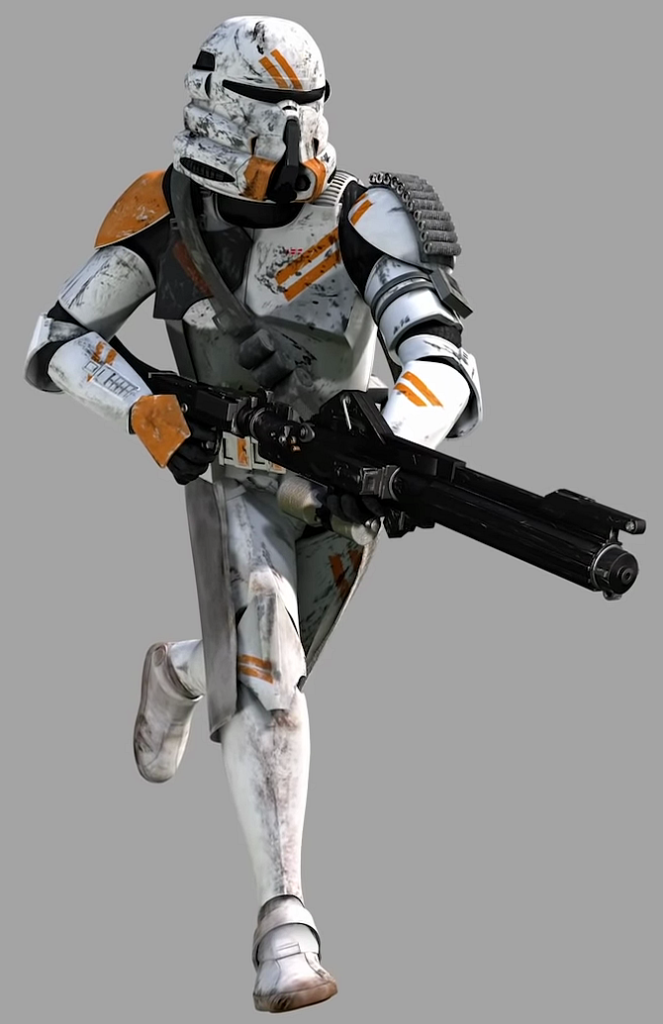
Paratrooper
Clone paratroopers, also known as airborne clones, were specialized clone troopers trained for airborne operations in the Grand Army of the Republic. Clone paratroopers wore a modified version of the Phase II clone trooper armor, that featured a kama and a unique, “beehive” helmet. They were equipped with DC-15A blaster carbines and DC-15A blaster rifles. Clones could volunteer or be selected for Paratrooper training during basic training.
Pararescue
Similar to the Clone Paratroopers, the Pararescue Clones were selected from Clones in the Medical field who also showed strong skills in combat. They would be attached to Paratrooper units and served as their Medical Clone and as a rapid rescue unit for injured clones in the field.

Scout Trooper
Clone Scout Troopers were trained for reconnaissance and warfare over difficult terrain. Before larger troop actions, small groups of the scouts were deployed to survey territory. Due of their survival skills, they were suited for fighting in wilderness conditions. Clones could volunteer or be selected to serve as Scout Troopers during basic training.
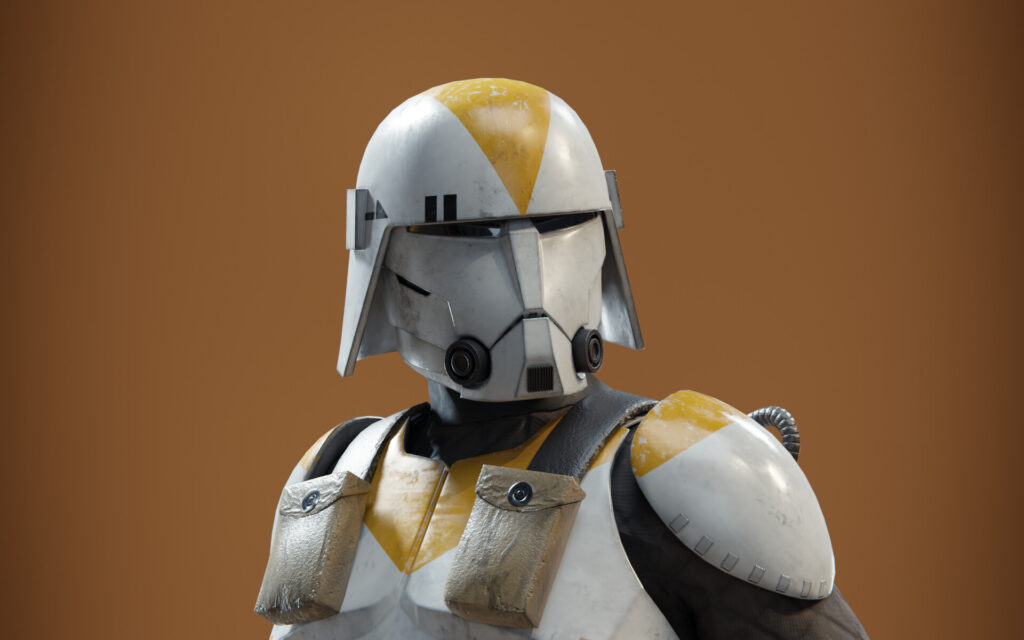
Desert Trooper
Clone Desert Troopers were trained to withstand high heat conditions or places such as deserts and dry planets. The armor used by Clone Desert Troopers was augmented with cooling fans and a helmet sand filter. In addition, they wore a survival backpack stocked with extra rations and water. They were trained to use CK-6 swoop bikes for patrol operations. Clones could volunteer or be selected to serve as Desert Troopers during basic training.
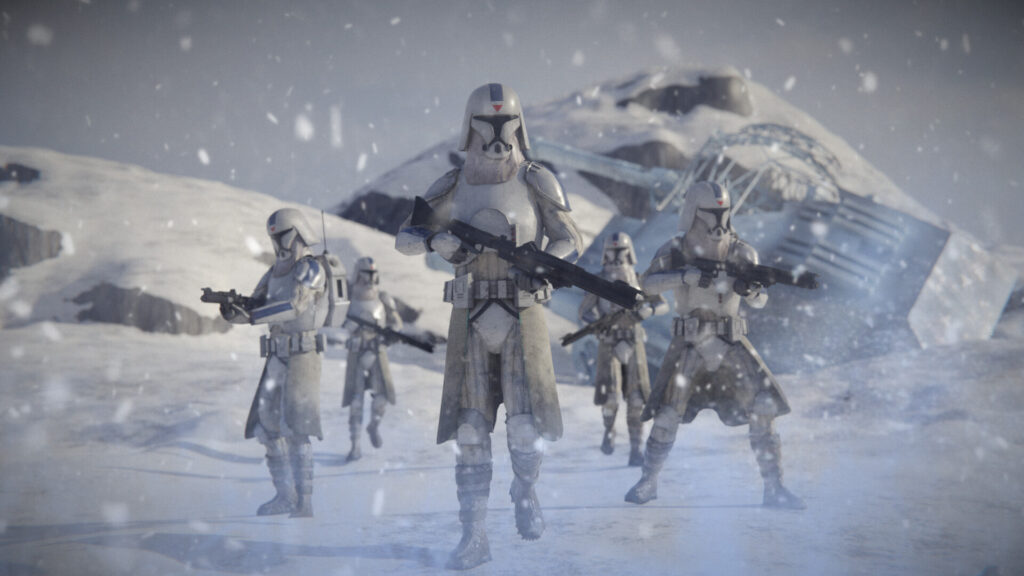
Cold Assault Trooper
Clone Cold Assault Troopers were specially trained for battle and survival in extremely cold regions. Their HT-77 Cold Assault Armor was specifically designed for protection to the wearer in extremely low temperatures and to allow for effective operations within this environment. They were trained to use CK-6 swoop bikes for patrol operations. Clones could volunteer or be selected to serve as Cold Assault Troopers during basic training.
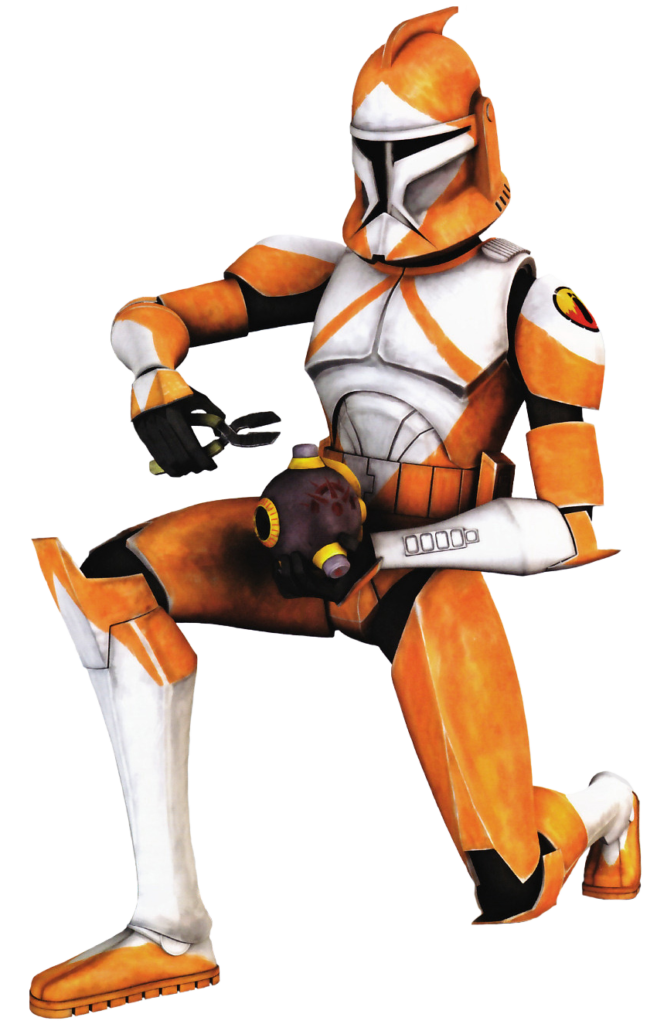
Clone Ordnance Specialist
Clone Ordnance Specialists were trained in disarming ordnance. Their uniform consisted of the standard Phase I or Phase II clone trooper armor with bright orange markings on the upper legs, the lower arms; and on the skull, the back of the head, and cheeks of the helmet. In addition to having special tools for bomb disarming, ordnance specialists could be armed with standard weapons of the Republic Army such as the DC-15A blaster carbine. Clones could volunteer or be selected for Ordnance Specialist training in basic training.
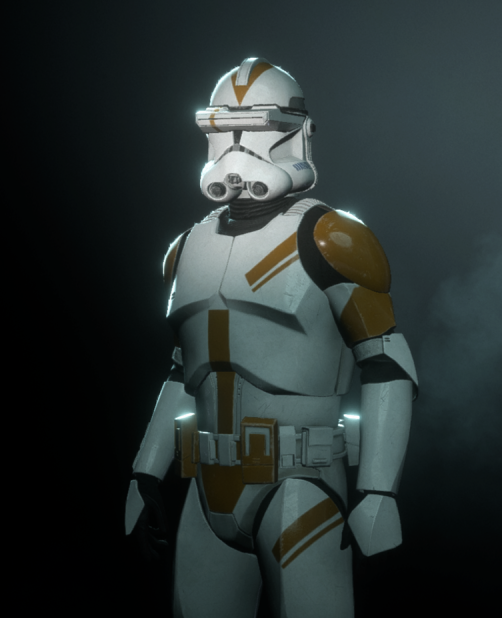
Sharpshooter / Sniper
Clone Sharpshooters were selected during basic training for their skills with the Blaster Rifle. If selected they received additional training in long range marksmanship, due to their ability to hit targets at extreme distance. Their skills are far superior to that of regular troopers in perception and blaster rifle. Clone Sharpshooters excelled at long-range combat, but were more vulnerable to close quarters engagements. Clone Specialists used either a Valken-38x sniper rifle, a DC-15A blaster carbine, or a DC-15A blaster rifle. They made use of helmet-mounted electrobinoculars, as well as an optional orange pauldron on their left shoulder.
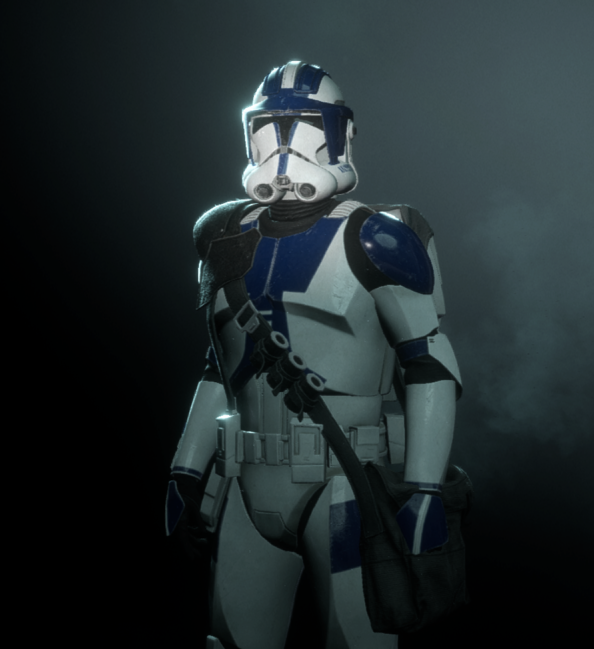
Heavy Weapons Trooper
The Clone Heavy weapons clone trooper was a specialized type of clone trooper that provided infantry with anti-vehicle support. They wore reinforced Phase I & II chest armor due to having to expose themselves more often in combat. When positioned well, they could take out many enemies, but were less mobile than other clones. Heavy weapons clone troopers utilized either DC-15A blaster rifles or DC-15LEs. Clones could volunteer or be selected for Heavy Weapons training during basic training.
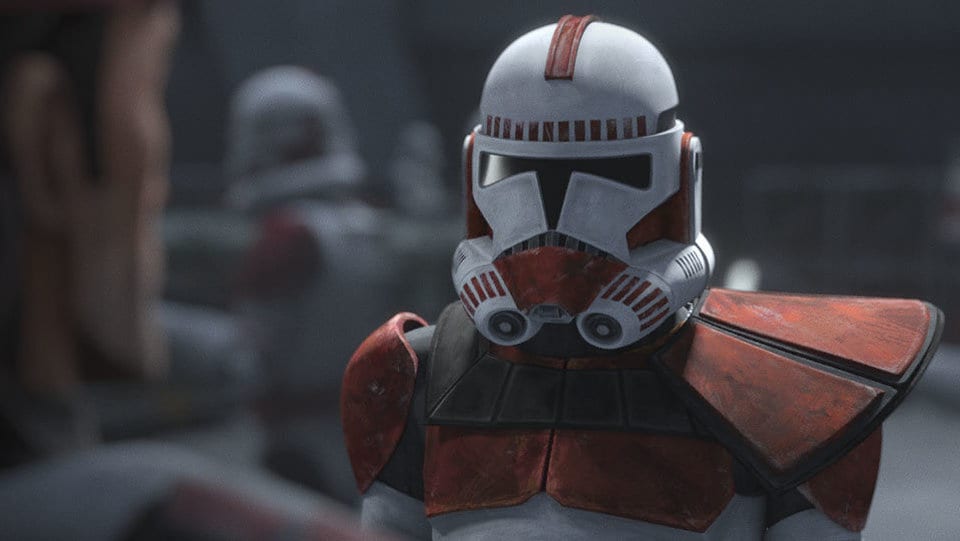
Shock Trooper
Clone Shock Troopers were highly skilled clone troopers that formed the Coruscant Guard during the Clone Wars. They were trained as elite shock troopers specifically for deployment on the planet Coruscant, and to provide security aboard Republic starships. Shock troopers served primarily as security police for Republic government buildings and as prison guards. They also performed duties such as bodyguards for Republic officials and as urban peacekeepers with some troopers trained specifically for riot control. In addition to the civilian police on Republic worlds, as military police they could take over investigations as well, and were treated as regular patrolling police when they were out and about.
Unlike most other clones who were issued white with officers bearing color markings, the Coruscant Guard armor was issued in red. The color scheme made the shock troopers a very distinctive unit within the Grand Army. Shock troopers were armed with DC-15A blaster rifles, DC-15Ss, and thermal detonators. They were also seen armed with RPS-6 rocket launchers, and Z-6 rotary blaster cannons during battle. They also employed electrostaffs for combat. Clones could not volunteer for Shock Trooper training but selected early on in their basic training and were isolated away from the other clones.
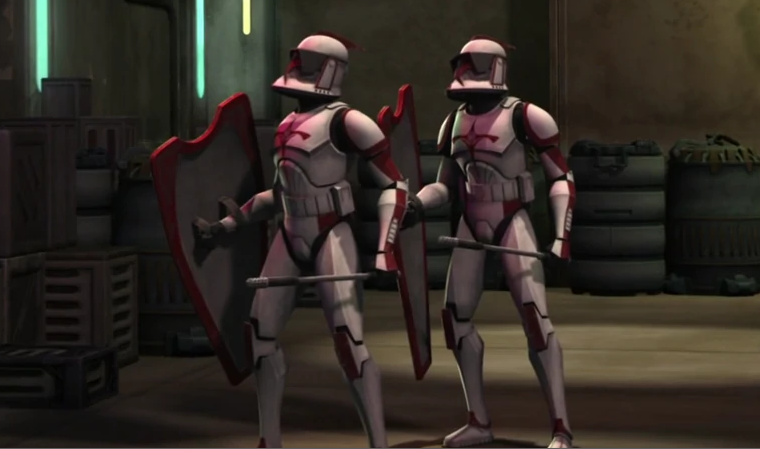
Riot Trooper
Clone Riot Troopers, were specialized clone shock troopers of the Coruscant Guard who were trained in riot control. They served on the planet Coruscant, where they patrolled the streets alongside members of the civilian police force and assisted in controlling crowds at demonstrations. Armed with shock batons and riot shields, riot clone troopers and were first equipped with Phase I clone trooper armor that sported a dark colored visor. The red markings on the armor were in slightly different styles in comparison with the rest of the Coruscant Guard. Later in the war, they were equipped with Phase II clone trooper armor, although the armor was equally uniformed as the rest of the Coruscant Guard, and were no longer modified with a visor. Select members of the Shock Troopers received

Advanced Recon Commando
Advanced Recon Commandos, also known as ARC troopers, were an elite variant of the clone troopers that served the Galactic Republic. Clones were selected for ARC training based on their combat skills in basic training. Clones could be selected for ARC training by their unit if they showed exceptional skills in combat as well. ARC troopers were equipped with ARC trooper armor, a variant of the clone trooper armor. It was outfitted with a double-sided pauldron, a kama, and breathmask survival gear. ARC troopers utilized dual DC-17 hand blasters, DC-15A blaster rifles, DC-15A blaster carbines, DC-15x sniper rifles, ascension cables, and reciprocating quad blaster cannons.
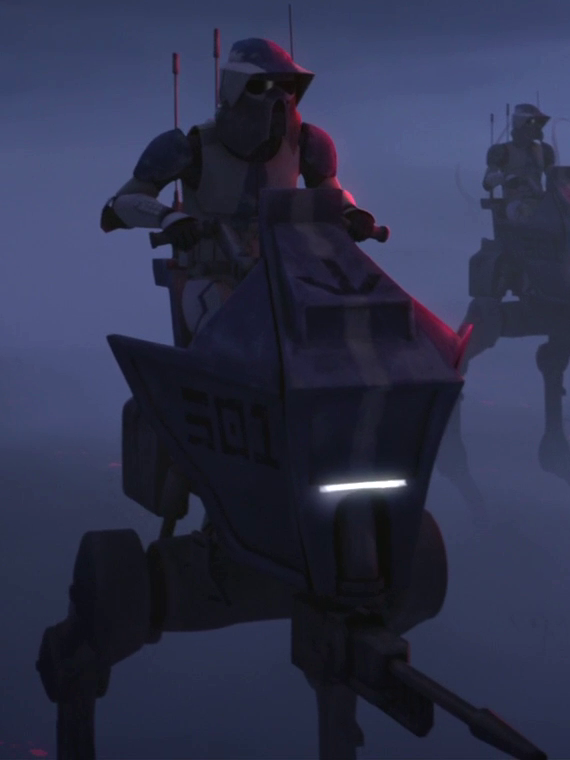
Advanced Recon Force Scout
Advanced Recon Force Scout Trooper were clone troopers who wore lighter armor for stealth and speed and often rode All Terrain Reconnaissance Transports into battle, wielding RPC-2 Rocket Launchers and DC-15A blaster rifles. Clones who showed that they were more intelligent during basic training were selected for ARF training. They were better trained in survival skills in comparison to other clones. These clone troopers were often tasked with scouting out the enemy position on the battlefield. Although stealthy and well-trained, recon troopers’ duties differed from that of Clone Commandos or Advance Recon Commandos as their focus was on gathering information about the enemy or carrying out surprise attacks.
ARF troopers were often provided with standard issue BlasTech Industries DC-15A blaster rifles, DC-15S blaster carbines, DC-17 hand blasters as well as missile launchers and thermal detonators. They also wore lightweight recon armor made of plastoid material and surveillance gear. The belt contained spare ammunition and a medical syringe. On their left arm they had a comlink and a life-form scanner. Their helmet had an infrared camera so that they could operate in dark places as well as recognizing friends or foes. They often carried a backpack with some basic items, such as survival rations, C.S.E.L. (Combat Survivor Evader Locator) and explosives, but it was possible to have rope, macrobinoculars, an ice pick and a medpac. They would often wear armor that fit the environment of the planet they were on. Some of these troopers could carry flamethrowers.

Biker Advanced Recon Commando
BARC troopers, were special forces clone troopers of the Grand Army of the Republic that were trained to ride BARC speeders across difficult terrain or dangerous battlegrounds. BARC troopers were equipped with modified clone trooper armor that directed their attention forward to avoid distractions, which could be dangerous to them at high speeds. Clones who showed exceptional skills in vehicle training and combat during basic training were selected to attend BARC training.

Commando
Clone commandos, also known as Republic commandos while serving under the Galactic Republic, were elite clone troopers that served in the Grand Army of the Republic’s Special Operations Brigade during the Clone Wars. Unlike regular clones, Clone Commanders were designed by the Kaminoans to be super soldiers. Clone commandos were equipped with Katarn-class Commando Armor, which came with a backpack where members kept various items like grenades and sabotage gear. They were allowed to choose the colors on their armor. In combat the commandos utilized the DC-17m Interchangeable Weapon System and the DC-17 hand blaster, though those at the Imperial Base on Daro like RC-1262 AKA Scorch used the DC-15A blaster carbines during the rise of the Galactic Empire. They had a small vibroblade in their right hand armor piece. Commandos could also use a grenade launcher.

Shadow Trooper
The Clone Shadow Troopers were an elite cadre of clone troopers, devised by Republic Intelligence during the Clone Wars to replace the dwindling numbers of Advanced Recon Commandos lost during the war. Designed as a Reconnaissance unit, who, with the benefit of greatly modified and expensive armor, could operate covertly and undercover. Using magseals installed in their armor, shadow troopers could attach plates to themselves that could pass them off as mercenaries belonging to certain factions. With that advantage, they could infiltrate facilities and gather intelligence with ease.
During the late stages of the war, the role of the shadow trooper expanded, with some performing sniper duties, while others would be used on the battlefield. Though their jamming systems would prevent them from working alongside standard troopers, shadow troopers were occasionally dispatched before large-scale invasions to install jamming devices in key cities, which would allow their comrades to infiltrate their targets with stealth and efficiency. Clones were selected based on their battlefield performance to be Shadow Troopers.

Artillery Trooper
Clone artillery troopers were clone troopers of the Galactic Republic that specialized in using mortars and other artillery pieces such as the Model 201 mortar system. Clones could volunteer for Artillery training during basic or be selected based on skills and test training.
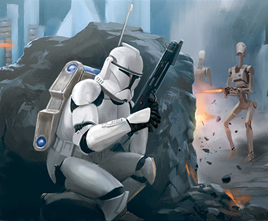
Communications Technician
Clone Communication Technicians were responsible for proper communication, making them essential for any army. They were equipped with specialized Phase I clone trooper armor and later Phase II clone trooper armor with a backpack that included a mid ranged encrypted signal booster and relay which allowed Communication with vehicles both in space and on the ground. Clones could volunteer to be a Communication Technician or be selected by their unit.
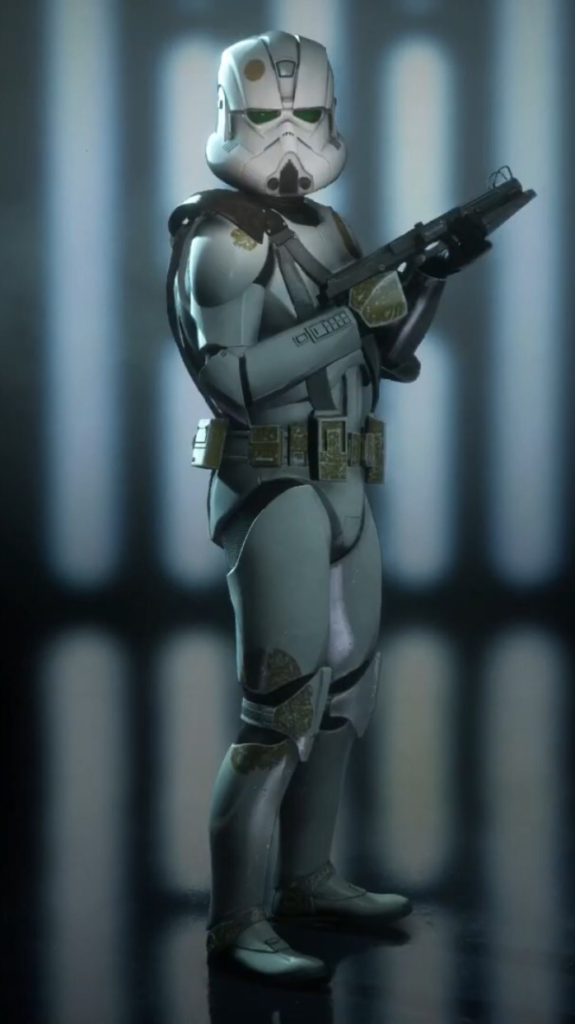
Naval Engineer
On Kamino some clones could volunteer or be selected to become engineers and became attuned to their vehicles and idiosyncrasies. Engineers during training would be further selected for additional training with the Republic Navy or as a Army Combat Engineer. Naval Engineers were assigned to select systems (Propulsion, Weapons, Sensors, etc…) and would service repairs on those systems as well as serve to repair battle damage in combat. Like all clone engineers they were equipped with a specialized toolkit that included F-187 fusioncutters that enabled them to repair vehicles, turrets, medical and power droids.
Combat Engineer
On Kamino some clones could volunteer or be selected to become engineers and became attuned to their vehicles and idiosyncrasies. Engineers during training would be further selected for additional training with the Republic Navy or as a Army Combat Engineer. On the battlefield they were assigned to heavy artillery units, such as HAVw A6 Juggernauts and SPHA units for armored ground assault. Clone Combat Engineers were equipped with dispensers that held bacta and ammunition, as well as F-187 fusioncutters that enabled them to repair vehicles, turrets, medical and power droids. They were armed with detonation packs for sabotage and shotguns, or blaster pistols in case they had to engage enemy units.
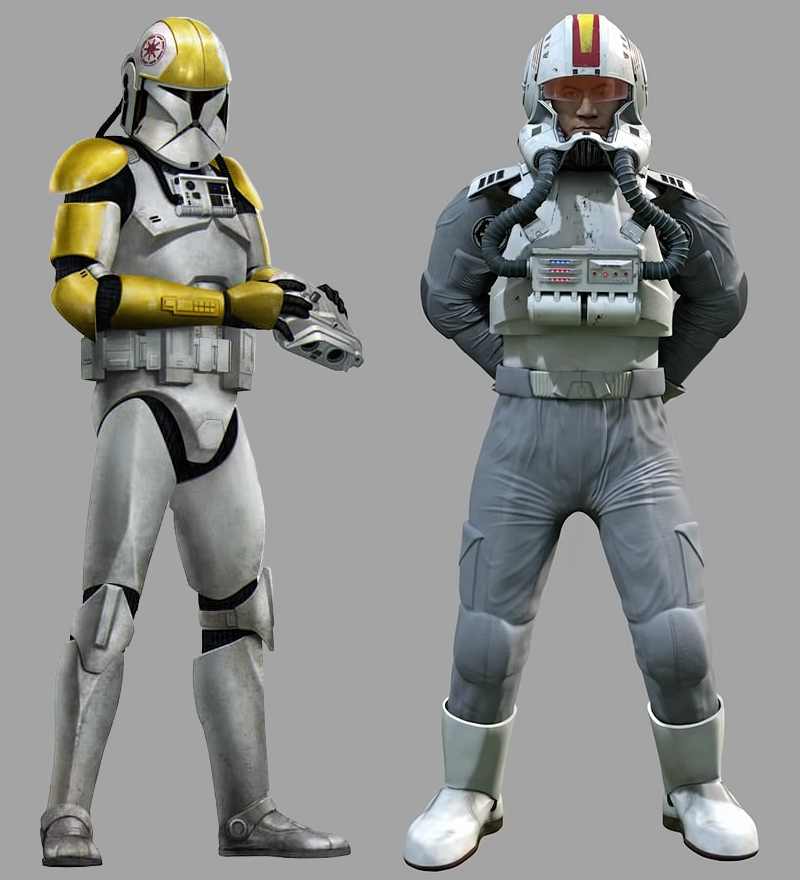
Pilot
Clones Pilots were selected due to having particularly good reflexes and spatial awareness, were spotted early and brought into pilot training early in basic training. Clone pilots flew various ships, such as the V-19 Torrent starfighter, the Clone Z-95 Headhunter, and the ARC-170 starfighter. Clone Pilots attended a special officer training program on Kamino that focused on space combat, patrols, and mission planning. They received limited ground combat training compared to regular clone troopers. Clone Pilots were able to increase rank faster than other clones.
Throughout the war, pilots wore at least three types of pilot armor, including two types of Phase II armor. One variant had identical body armor to the Phase I armor, but had a different helmet which allowed for much better respiration. The second variant had a blue bodysuit, and plating covering the torso, as well as minor plating covering the knees and elbows. The helmet was open to allow much better sight, however could not supply oxygen in case of emergency.
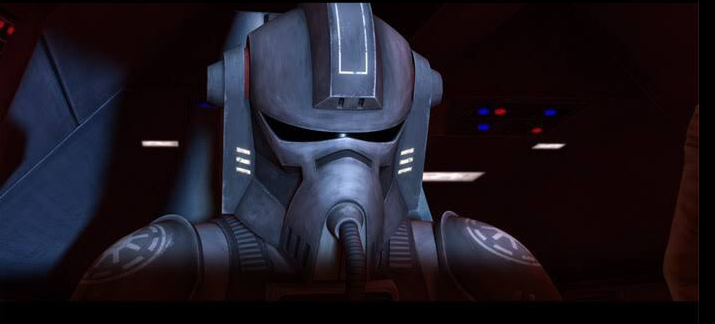
Stealth Pilot
Stealth clone pilots were clone troopers of the Galactic Republic that were trained to pilot stealth vehicles such as the IPV-2C Stealth Corvette. This was a specialized training that Clone Pilots could be selected to receive training on during basic training based on testing and pilot training scores.
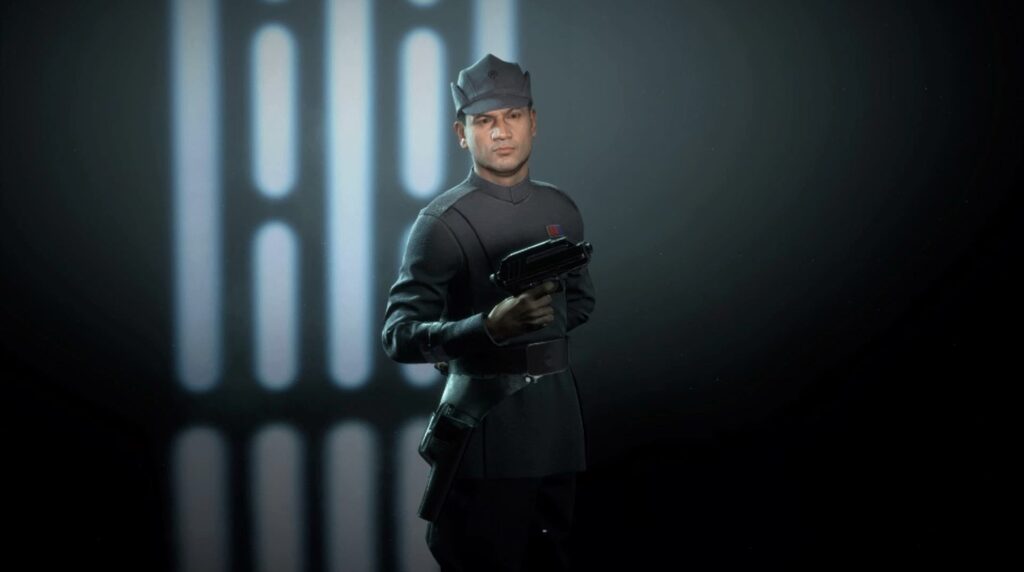
Naval Officer
Clone navigation officers were clone troopers who assisted in crewing Star Destroyers and other starships in the Republic Navy during the Clone Wars. Many often served onboard Venator-class Star Destroyers controlling the ship’s weapons, navigational and communications systems. They received the standard Clone Officer basic training and then were selected for their system training upon graduation and receive placements as Navigation, Weapon, Defense System, or Communication Officers in the Republic Navy.
Clone navigation officers wore gray uniforms with black boots and gloves as well as a belt and a gray cap. They also wore rank insignia plaques on their chests. During the final year of the Clone Wars and the early days of the Empire, they wore black uniforms and caps, later similar to Imperial officers.
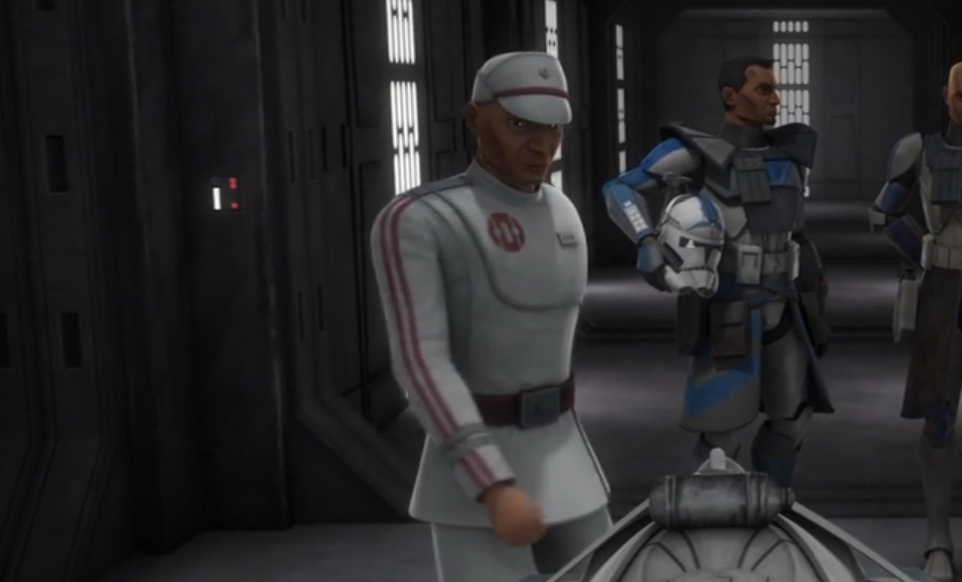
Medical Officer
Clone Medical Officers specialized in medical treatments. They served aboard Haven-class medical stations and other starships during the Clone Wars. Trained in healing like clone trooper medics, clone medical officers were specifically stationed aboard hospital stations and ships throughout the galaxy. They attended the basic officer training program then attended specialized medical training that included emergency surgery, bacta tank operation, biochemistry, anatomy, hematology, oncology, pathology, toxicology, pharmacology, genetics, and advanced medicine. Training a Medical Officer took five years and they were very valuable to the Republic and later the Empire.

Maintenance & Support
Clones that were not assigned to combat or officer training were assigned maintenance and support duties. These clones would serve in a variety of positions such as Financial Management , Transportation (Ground Vehicle Driver), Mechanical Maintenance (general mechanic), Quartermaster Corps (supply), Munitions Systems, Loadmaster, Fuels (ground and starship), Fire Protection (Damage Teams), or Services (Food Preparation and Janitorial and Disposal).
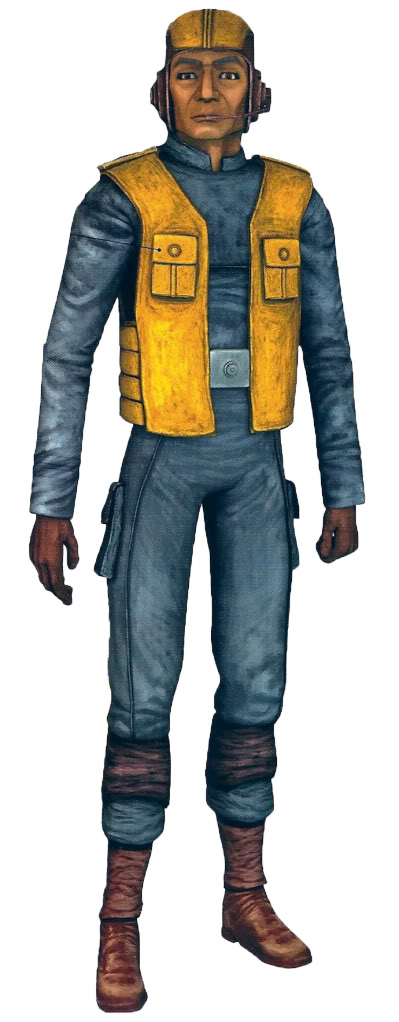
Crew Chief
Clone Crew Chiefs would be trained in the service and repair of vehicles for ground, air, and space. During basic training Clones who showed high skills with mechanics could volunteer or be selected to serve as Crew Chiefs. They would further be selected for servicing ground, air, or space vehicles. They would oversee the servicing and repair of their assigned vehicles and work with Maintenance and Support clones.

